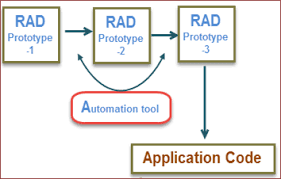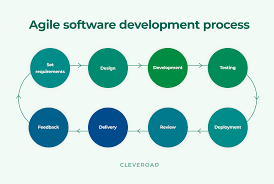Exploring the Dynamics of RAD Software Development: A Modern Approach to Agile Solutions
Rapid Application Development (RAD) in Software Development
Rapid Application Development (RAD) is an agile software development approach that prioritizes rapid prototyping and quick feedback over long planning and extensive upfront design. RAD aims to accelerate the development process by focusing on iterative development and user feedback.
Key Features of RAD:
- Iterative Development: RAD emphasizes building software in small increments, allowing for quick iterations and continuous improvement.
- User Involvement: Users play a crucial role in the RAD process, providing feedback early and often to ensure that the final product meets their needs.
- Rapid Prototyping: Prototyping is a central component of RAD, enabling developers to create working models quickly for validation and feedback.
- Collaborative Approach: RAD encourages collaboration among cross-functional teams, including developers, designers, and stakeholders, to foster creativity and innovation.
- Flexible and Adaptive: RAD is highly flexible and adaptive to changes, allowing for adjustments based on evolving requirements and feedback throughout the development cycle.
Benefits of RAD:
RAD offers several advantages for software development projects:
- Reduced Time-to-Market: By focusing on rapid iterations and quick feedback cycles, RAD helps accelerate the delivery of functional software.
- Improved User Satisfaction: User involvement throughout the development process ensures that the final product aligns with user expectations and requirements.
- Increased Flexibility: The iterative nature of RAD allows for changes to be incorporated easily, making it ideal for projects with evolving or unclear requirements.
- Better Risk Management: Early prototyping and frequent testing help identify potential issues early on, reducing risks associated with large-scale implementation.
- Creative Problem-Solving: The collaborative nature of RAD fosters creativity and innovation within teams, leading to unique solutions to complex problems.
In conclusion, Rapid Application Development (RAD) is a dynamic approach to software development that prioritizes speed, flexibility, collaboration, and user satisfaction. By embracing rapid prototyping, iterative development cycles, and continuous user feedback, RAD enables teams to deliver high-quality software solutions efficiently while adapting to changing requirements effectively.
Understanding RAD in Software Development: Key FAQs Answered
- What does RAD stand for in development?
- Is agile and RAD same?
- What is RAD and agile?
- What are the 5 stages of the RAD model?
- What does RAD stand for in agile?
- What is RAD in software development?
- What are the four phases of RAD software development?
- What is the RAD model in software development?
What does RAD stand for in development?
Rapid Application Development (RAD) in software development refers to an agile approach that emphasizes quick prototyping, iterative development, and user feedback to accelerate the delivery of functional software solutions. RAD stands for a methodology that prioritizes speed, flexibility, and collaboration among cross-functional teams to ensure that the final product meets user requirements effectively. By focusing on rapid iterations and continuous improvement based on user input, RAD enables developers to build and refine software applications efficiently while remaining adaptable to evolving project needs.
Is agile and RAD same?
The frequently asked question about Rapid Application Development (RAD) and Agile often revolves around whether they are the same approach. While both RAD and Agile share some common principles, they are distinct methodologies in software development. RAD focuses on rapid prototyping, quick iterations, and user involvement to accelerate the development process, while Agile is a broader umbrella term encompassing various iterative and incremental approaches, including Scrum and Kanban. While both emphasize flexibility, collaboration, and customer feedback, RAD specifically emphasizes rapid application delivery through prototyping and user engagement, whereas Agile is a more overarching framework that can incorporate RAD principles among others.
What is RAD and agile?
Rapid Application Development (RAD) and Agile are both iterative software development approaches that prioritize flexibility, collaboration, and responsiveness to change. While RAD focuses on rapid prototyping and user involvement to accelerate the development process, Agile is a broader methodology that emphasizes adaptive planning, continuous improvement, and cross-functional teamwork. Both RAD and Agile share common principles such as iterative development, user feedback, and a collaborative approach but differ in their specific techniques and scope. Ultimately, RAD and Agile methodologies aim to enhance software development efficiency, quality, and customer satisfaction through dynamic and iterative practices tailored to meet evolving project requirements.
What are the 5 stages of the RAD model?
The Rapid Application Development (RAD) model typically consists of five key stages: Requirements Planning, User Design, Rapid Construction, Cutover, and Feedback. In the Requirements Planning stage, project requirements are gathered and analyzed to establish the scope of the software development project. The User Design stage involves creating prototypes and mock-ups based on user feedback to ensure that the final product meets user expectations. During Rapid Construction, developers build the software in iterations, focusing on functionality and quick delivery. The Cutover phase involves transitioning from development to production, while Feedback allows for continuous improvement based on user input and testing results. These five stages form a structured yet flexible framework for implementing RAD methodologies in software development projects.
What does RAD stand for in agile?
In the context of agile software development, RAD stands for Rapid Application Development. RAD is an approach that emphasizes quick prototyping, iterative development, and close collaboration with users to accelerate the delivery of software solutions. By focusing on rapid iterations and continuous feedback, RAD enables teams to respond quickly to changing requirements and deliver high-quality applications efficiently.
What is RAD in software development?
Rapid Application Development (RAD) in software development is an agile methodology that focuses on accelerating the development process by emphasizing quick iterations, user involvement, and rapid prototyping. RAD aims to deliver functional software solutions faster by breaking down the development cycle into smaller increments, allowing for continuous feedback from users and stakeholders. This approach enables teams to adapt to changing requirements more effectively and deliver high-quality software that aligns closely with user needs.
What are the four phases of RAD software development?
In Rapid Application Development (RAD) software development, the process typically consists of four key phases. The first phase is Requirements Planning, where project goals and objectives are defined, and initial user feedback is gathered. This is followed by User Design, where prototypes are created based on user input to visualize the final product. The third phase is Rapid Construction, where the actual development takes place in iterative cycles to build and refine the software incrementally. Finally, the Implementation phase involves testing, deployment, and user training to ensure a smooth transition to the new system. These four phases of RAD software development emphasize collaboration, rapid prototyping, and continuous feedback to deliver high-quality software solutions efficiently.
What is the RAD model in software development?
The RAD model, short for Rapid Application Development, is an agile software development approach that focuses on iterative development, quick prototyping, and user feedback to accelerate the delivery of software solutions. In the RAD model, software is built in small increments with a strong emphasis on collaboration among cross-functional teams and active involvement of end-users throughout the development process. This approach allows for rapid adaptation to changing requirements, early identification of potential issues, and ultimately results in the creation of high-quality software products that align closely with user needs and expectations.









